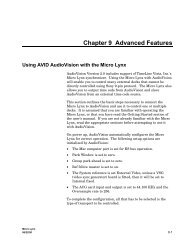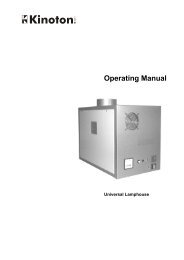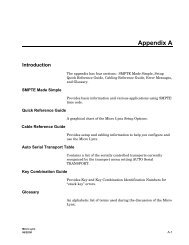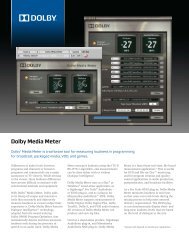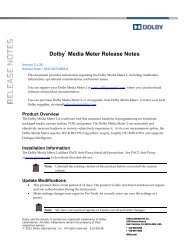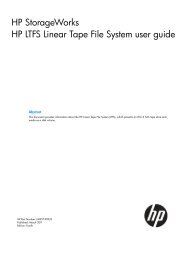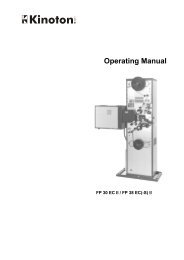Dolby LM100 Broadcast Loudness Meter User's Manual
Dolby LM100 Broadcast Loudness Meter User's Manual
Dolby LM100 Broadcast Loudness Meter User's Manual
You also want an ePaper? Increase the reach of your titles
YUMPU automatically turns print PDFs into web optimized ePapers that Google loves.
The Status Menus<br />
The value at the far right is the largest peak value currently being measured from any<br />
individual channel within the program. This peak meter has an instant attack, a peak hold<br />
of 0.75 second, and a constant decay of 12 dB/second, ±2 dB/second, following the peak<br />
hold.<br />
The main status screen also provides different display modes. Press Enter to scroll through<br />
these different modes on the right side of the screen.<br />
When measuring <strong>Dolby</strong> Digital or <strong>Dolby</strong> E signals, the far right section of the default screen<br />
shows the setting for the dialnorm value contained in the metadata stream. If you press<br />
Enter, this section of the display shows the largest true‐peak value. If you press Enter a<br />
second time, this section of the display shows the largest sample peak value. If you press<br />
Enter a third time, the screen displays only a single, larger magnification of the loudness<br />
measurement. Pressing Enter a fourth time displays the default screen where the dialnorm<br />
value appears on the far right.<br />
Note:<br />
When the measurement type is ITU‐2, one additional measurement is included in<br />
this sequence of displays (the loudness range measurement). The display sequence<br />
repeats following this measurement screen.<br />
Note:<br />
When the measurement type is EBU mode, two additional measurements are<br />
included in this sequence of displays. In addition to the loudness range<br />
measurement, the display sequence includes a momentary maximum loudness<br />
measurement. The display sequence repeats following this measurement screen.<br />
If the <strong>LM100</strong> is using the infinite method with Dialogue Intelligence enabled and dialogue<br />
is not detected, the measurement value holds and begins to flash until the unit detects<br />
dialogue again.<br />
When using the short‐term method with Dialogue Intelligence enabled, if dialogue is not<br />
detected, the measurement value flashes and a second value appears at the bottom of the<br />
center section, as previously discussed. That value shows the current non‐dialogue‐based<br />
measurement; the flashing value shows the last valid dialogue‐based measurement, and<br />
the time counter in the lower left section shows the time elapsed since the dialogue‐based<br />
measurement stopped.<br />
When dialogue‐based measurement resumes, the time counter and the second value no<br />
longer appear. When you select the analog input, an additional display mode is now<br />
available. This additional mode displays the recommended value for setting the dialogue<br />
level parameter in downstream <strong>Dolby</strong> Digital or <strong>Dolby</strong> E encoding equipment; this<br />
recommended value allows the operator to simply calculate a dialnorm value when<br />
measuring analog sources. Figure 4‐10 shows an example of this display.<br />
<strong>Dolby</strong> ® <strong>LM100</strong> <strong>Broadcast</strong> <strong>Loudness</strong> <strong>Meter</strong> User’s <strong>Manual</strong> 21




